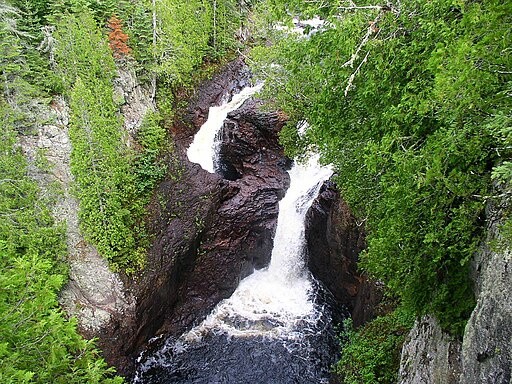The Brule River flows through Judge C. R. Magney State Park in Minnesota, a few miles from the US-Canadian border. This river creates several waterfalls, dropping 800 feet (244 meters) in an 8-mile (13-kilometer) span.

About one and a half miles north of the shore of Lake Superior, a large piece of rock divides the river at the crest of the falls. To the eastern side, a traditional waterfall flows in a downward path. On the western side, tourists and visitors witness a geological mystery. A giant pothole, known as the Devil's Kettle, swallows half of the river without showing signs of where it goes.
Mystery of the Devil's Kettle Waterfall
Devil's Kettle has stumped visitors and geologists for several reasons. First, the rock that forms the Kettle is rhyolite. It comes from a volcanic eruption, and it is not unusual to find small kettles in this kind of rock. However, the Devil's Kettle Waterfall is special because this is not a small, shallow pothole. Its bottom cannot be seen, and its actual exit point remains unknown.
The consensus is that there must be an exit point beneath Lake Superior. Over the decades, tourists and scientists have tossed in logs and even dyes in hopes of tracing the flow of this river. Others tried throwing ping pong balls and even road signs, watching the lake for any sign of them. So far, none of them has ever been found. There was even a report of a man going 26 feet down into the hole and reportedly not being able to see the bottom. Residents theorize that the water separated from the main River, traveled through underground tunnels, and emerged somewhere in Lake Superior or elsewhere. There were also rumors that the water splits at the waterfall and some flows into Canada. For others, it may be flowing back into the Mississippi River.
READ ALSO : Mauritius Underwater Waterfall an Optical Illusion? One-of-a-Kind Phenomenon Due to Sand Erosion
Where Does the Water Go?
In February 2017, the Minnesota Department of Natural Resources reported that the water disappearing into the rock at Devil's Kettle resurges in the stream below the waterfall. To see if some water was lost somewhere between the two locations, hydrologists compared the amount of water that flowed above the waterfall with the amount that flowed below it.
In the fall of 2016, the water flow above Devil's Kettle was measured to be about 123 cubic feet per second. Meanwhile, several hundred feet below the waterfall, the water flows at 121 cubic per second. According to a statement by DNR spring shed mapping hydrologist Jeff Green, the readings do not show a water loss below the Kettle, so it confirmed that the water resurges in the stream below it.
The research team planned on conducting a dye trace to confirm this theory. They poured a vegetable-based dye into the pothole and watched where the water resurfaced. In this study, the scientists used a fluorescent, biodegradable dye, visible at ten parts per billion.
The team suggested that the water is going in the Kettle and comes up immediately downstream of the falls. Regarding the disappearing items that never reappear, they noted that his event has no mystery. They believe that the plunge below the Kettle is a powerful system of recirculating current that can disintegrate lateral and hold it under water until it resurfaces at some point downstream.
RELATED ARTICLE : Mysterious Blood Waterfall in Antarctica Finally Solved; Scientists Discovered Why Taylor Glacier Bleeds Red Drool
Check out more news and information on Waterfall in Science Times.
© 2025 ScienceTimes.com All rights reserved. Do not reproduce without permission. The window to the world of Science Times.










